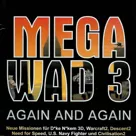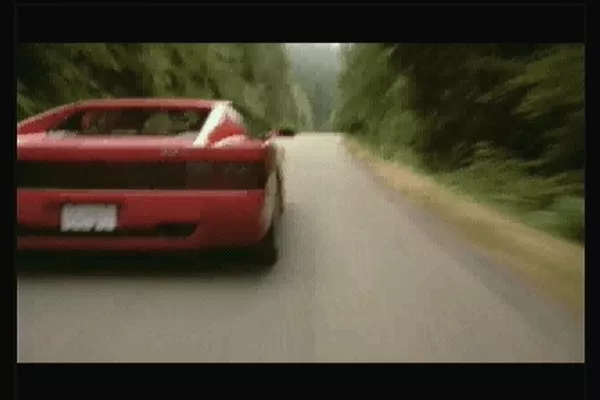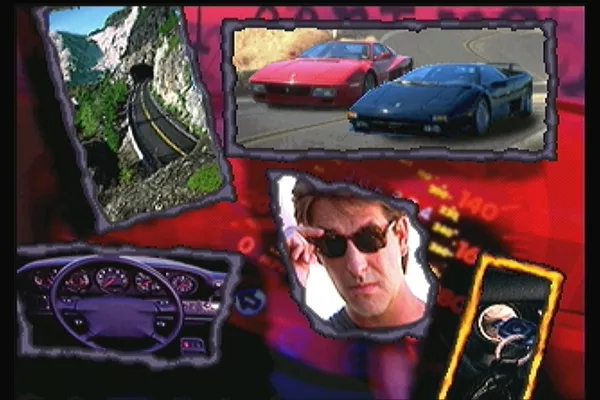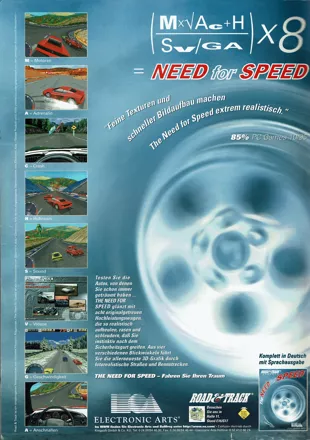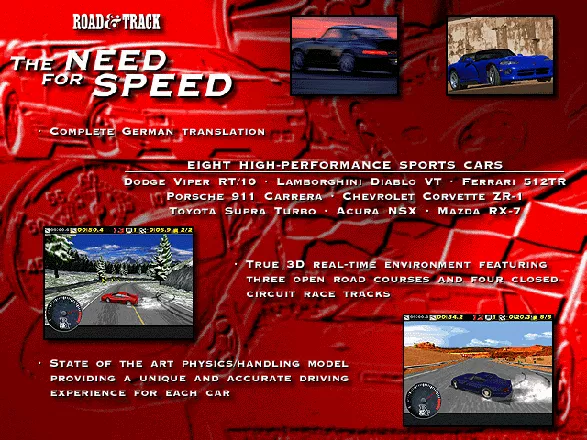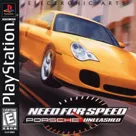The Need for Speed
Description official descriptions
Drive some of your favourite sports cars through wild and fast tracks, including the Dodge Viper, Lamborghini, Ferrari, Porsche, Corvette, Mazda RX7, Toyota Supra Turbo, and Acura NSX. Some of the tracks are open road, meaning you simply fly down a huge highway, with cops following in hot pursuit. One of the options in the game allows you to pick which time of the day to race in.
Spellings
- Road & Track Presents: Over Drivin': オーバードライビン - Japanese 3DO spelling
- オーバードライビンGT-R - Japanese Saturn spelling
Groups +
Screenshots
Promos
Credits (3DO version)
66 People (47 developers, 19 thanks) · View all
| Lead Programmer | |
| Programming | |
| Lead Artist | |
| Artists | |
| Track Modeling | |
| Additional Artists | |
| Lead Audio | |
| Additional Audio Programming | |
| Music Producer | |
| Additional Music |
|
| Audio Post Production | |
| Lead Tester | |
| Additional Testing | |
| Production Assistant | |
| Assistant Producers | |
| [ full credits ] | |
Reviews
Critics
Average score: 83% (based on 42 ratings)
Players
Average score: 3.8 out of 5 (based on 85 ratings with 2 reviews)
The Good
Being the first part of probably the most successful racing game series on the PC, that fact alone should already be reason enough to give this one a go and have a look at what it was like in the beginning. The game welcomes you with one of its many FMV sequences, accompanies by nice but lo-fi rock music. The eight cars you can drive (Ferrari Testarossa 250, Lamborghini Diablo VT, Chevrolet Corvette ZR-1, Dodge Viper RT/10, Porsche 911 Carrera, Honda Acura NSX, Mazda RX-7, Toyota Supra Turbo) all are very fast, very expensive, very neat looking - in short, a dream come true. What's so special in Need for Speed compared to other racing games of the same age is how deep it goes into the details of those cars you can drive. Each car has its own showroom where you can get technical specs, a price tag, the history of the manufacturer and the car model, a photo gallery and a video clip. All of which is very interesting and well done.
The same goes for the six fictional race tracks you can choose. There are three courses and three long runs - on the first type of track you race a number of laps, the available sceneries are Rusty Springs, a closed race-track in the desert, Autumn Valley, a high-speed touring car race track and Vertigo Ridge, the graphically most beautiful race-track, leading you through a mountain area with a church, a village, a waterfall, a castle, a wooden bridge and many other sights. The other type gives you the possibility to drive a route from one point to another, over a distance of about 20 miles. Those tracks are divided into 3 runs of which the times are added at the end to find out about the winner. There you can choose from the city track which leads you from the suburbs through the industrial area into the down town of a big city, the coastal course taking you along sandy beaches and rocky cliffs of a beautiful ocean holiday resort, and alpine, which takes you from the farms in the lowlands up through frozen hairpins to a big lake. The details which you can see while enjoying all of those tracks were second to none when the game was released, and they are still impressive today.
In single player mode, there are 4 types of playing. In time trial, you race alone against the clock, while in single race, you have 5 opponents against you. The championship mode lets you simply compete in a single race on all of the six tracks. If you win the tournament, you will get a bonus car (The Warrior) and a bonus track (Lost Vegas). Achieving this, however, isn't that easy, because there is always one opponent which is very strong and wins all of the races if you don't. Which means that you can't just be "good" in most of the races in order to win - you have to place first in 3 of 6 races, because otherwise, the leader of the pack does. The last game mode is called duel, and this is where the fun comes in. You race against only one opponent, but this time around, there are two special things on the three road tracks. One, there is civil traffic which you have to avoid. Two, there are cops which will start chasing you if they catch you speeding. What follows is a high-speed chase in which you'll have to try and lose your tail, because if the cops overtake, you can't do anything but stop and receive your ticket, which costs a lot of time (but least doesn't have any other negative effects). Single race and duel can also be played together with a friend over a serial connection, a modem or an IPX network.
The cars all look very good, they even come with their own photo-realistic, animated cockpit which is probably one of the coolest features you can have in a racing game. Further, every car has its own physical behaviour, as well as its own sound effects which have been recorded from the real cars during the development of the game. This ensures that each of the eight cars really has its own character.
The game lets you choose if you want to use ABS and/or traction control - if the chosen vehicle supports them. After every race, you can watch a full replay or a selection of race highlights which the game automatically assembles from starts, drifts, crashes and jumps. There are even VCR-like controls during playback, which is far from natural for a game that age.
The Bad
First of all, the menus are not really user-friendly. The rather important option of selecting a race type is hidden within a text menu, which seems even more absurd considering its use can change the options available at the main screen. What I also missed was a damage model for the cars.
The main downsides of the game, however, are the physics and the track borders. It's cool to let the cars each have their own physics and handling. But what good is it if the basic physics engine of all the cars doesn't seem realistic. After telling you that the cars have a nearly simulation-like handling realism, the actual handling is like a big joke. The cars seem way to unresponsive, and what you do is not finding the right strategy and braking tactic to cleanly drive around corners, but keeping your car in the bottom center of your screen and trying to drift it around so it doesn't hit the oncoming track borders. The feeling is beyond words, it just feels ridiculous if you play it. I think the mistake is the high expectation people (like me) have when firing up this game - even if the presentation and the features of the game make it look like a simulation, the game mechanics are as arcade-like as it gets. Which makes this game actually a member of neither category.
But the most annoying thing ever must be the border of the tracks. You see, the designers especially designed the tracks that way so it always seems logical why you can't leave the track. There's always a barrier, a wall or something like that which tells you why you crash into it and don't drive through it. And what did those precious programmers do? They placed the actual track border one or two meters inside the track. It will happen so often that you think you can cut the corner without hitting anything, when your car slams into that invisible wall and starts spinning or tipping over. This is no longer a technical limitation, it's a major design flaw and takes away much of the fun.
The Bottom Line
The Need for Speed is a game for sports car enthusiasts which enjoy taking a nice virtual drive in one of the most expensive cars you could get. The wonderfully detailed tracks and the whole presentation will make it worthwhile. But don't you dare expecting a driving simulation - if you don't take this game for the arcade racer it is, you will be very disappointed.
DOS · by Daniel Saner (3509) · 2005
The Groundbreaking Masterpiece that Spawned a Series
The Good
To fully appreciate the impact of The Need for Speed, think back to 1995. Your desktop PC was probably a midrange Pentium with a quad-speed CD-ROM drive and 16 megabytes of ram. Your game collection consisted mostly of sprite-based adventure titles and some low-res textured driving and flight sims. Most of them came on floppy disks, and the few CD-ROM titles you might have owned (perhaps Myst or The 7th Guest) merely allowed you to click your way through pre-rendered rooms interspersed with poorly-acted video cutscenes.
Along comes The Need for Speed, with tons of Hollywood-quality video sequences, an electrifying 16-bit rock-n-roll soundtrack and spectacular high-resolution 3D textured graphics, with all the cars your pimply teenage ass had been lusting after for years. It was enough to make you turn off your Nirvana album!
Simultaneously innovative, polished and enthralling, The Need for Speed made you realize why you bought a Pentium in the first place. To start with, it offered one of the best implementations of "multimedia" CD-ROM technology to date, providing superb audio, lots of high resolution images, exciting full-motion videos and top-quality narration that described every car and track in detail. Every car had a "showcase" with statistics, historical information, performance characteristics, photographs and a short video clip. Even the tracks were described in detail by the narrator.
Once inside the car, you were treated to high-res textured 3D unlike any you'd ever seen before. The cars had spinning wheels and working brake lights, environments were populated with plenty of trees and buildings, and the steering wheel turned along with your joystick. The artwork was top-notch, colorful and slightly stylized with occasional touches of the surreal, like the half-buried Statue of Liberty at the end of the Coastal track. Burnouts laid stripes on the road surface and hard collisions sent cars tumbling through the air in a physically believable way. Graphically, the game was a jaw-dropping feast for the eyes.
The Need for Speed also offered some of the best sound ever heard in a PC game. Menu screens were accompanied by catchy rock music and once on the track, you were treated to a great variety of sounds from the vehicles and environment. Gearshifts produced a satisfying "clunk" sound, opponents honked at you and the wind howled at high speed. Driving through tunnels even caused echo and distinct changes in ambience.
Gameplay was solid, with excellent track design and superb AI. Each course had a distinct look and feel, offering long stretches of straightaway interspersed with curves and hills that sent you airborne. Your opponents would block you wherever they could, while ordinary road traffic and police cars added to the challenge. Though not as realistic as contemporary racing titles from Papyrus, car handling was believable and each vehicle had a unique character, with the Porche tending to oversteer and the Vette plowing to the outside of tight turns. The Viper was heavy but offered a lot of grunt. The RX-7 was nimble but its rotary engine struggled to keep up with the rest of the pack. Play balancing was excellent, making racing a challenge whether you were driving the Ferrari or the Toyota.
In short, The Need for Speed did an awful lot, and it did it right.
The Bad
It's hard to criticize The Need for Speed without sounding picky, but there are a few minor annoyances worth mentioning. Though you can turn around and drive backwards on each track, the camera always pointed ahead, apparently due to a limitation in the game's graphics engine. This made it very difficult to, say, smash head-on into your helpless opponents as they raced around the circuit.
There is also no damage model, despite the game's quasi-realistic physics. Since TNFS was a cross between arcade racer and serious sim it would have been nice to have a user-selectable damage option, but auto manufacturers are typically opposed to seeing their licensed products demolished onscreen.
The game also limits your driving to the paved track, so wandering slightly onto grass or gravel presented you with an invisible wall. This boundary was a bit too close to the racing line in spots, occasionally making for some annoying moments.
The Bottom Line
At the time of its release, The Need for Speed was a quantum leap for PC driving games. Fully capitalizing on the power of the Pentium processor, its beautiful high-resolution graphics and fun gameplay set new standards across the board. Twelve years later, it's still as playable as ever, and quite a bit better than many of the later releases in the NFS series.
DOS · by SiliconClassics (848) · 2007
Trivia
Extras
The Japanese Sega Saturn version of this game was supplied with a custom Nissan keyring made out of metal.
Intro animations
The game has three different FMV animations that are every time picked randomly as an intro sequence spin-offs. If you started game just a couple of times, there's a big chance you won't even notice that, as all three animations presents cars running the nature or polygons, with the same engine roar, but with the different music in the background.
Japanese Saturn version
The game's Japanese Sega Saturn version, Over Drivin' GT-R, is notable for only having Nissan vehicles (hence the Nissan Presents and the GT-R on the game's title) and apparently having different vehicle physics from every other version of the game.
Awards
- GameStar (Germany)
- Issue 12/1999 - #28 in the "100 Most Important PC Games of the Nineties" ranking
- PC Player (Germany)
- Issue 01/1996 - Best Racing Game in 1995
Information also contributed by プルスマン
Analytics
Upgrade to MobyPro to view research rankings!
Identifiers +
Contribute
Are you familiar with this game? Help document and preserve this entry in video game history! If your contribution is approved, you will earn points and be credited as a contributor.
Contributors to this Entry
Game added by MAT.
PlayStation, SEGA Saturn added by Kartanym. 3DO added by quizzley7.
Additional contributors: Kartanym, Charles Lippert, ケヴィン, Luchsen, Lance Boyle, Patrick Bregger, Skippy_Chipskunk.
Game added August 15, 2000. Last modified August 9, 2024.

